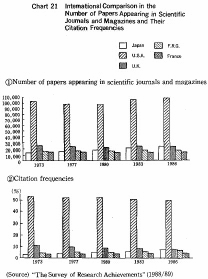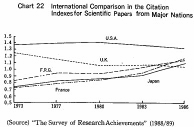| Home > Policy > White Paper, Notice, Announcement > White Paper > JAPANESE GOVERNMENT POLICIES IN EDUCATION,SCIENCE AND CULTURE1991 > Part |
||
The Survey of Research Achievements compared the number of papers appearing in scientific journals and magazines and the citation frequencies, using the Science Literature Indicators (SLI) complied by Computer Horizons, Inc., U.S.A., on the basis of the Science Citation Index (SCI) of the Institute for Scientific Information (ISI). U.S.A.(see Chart 21).
Chart 21 (1) refers to the total number of papers by researchers from Japan, the United States, the United Kingdom, Germany (formerly West Germany) and France, which appeared in scientific journals respectively in 1973, 1977, 1980, 1983 and 1986 in the fields of clinical medicine, biomedicine, biology, chemistry, physics, earth and space science, engineering and technology, and mathematics. Chart 21 (2) refers to the citation frequencies of these papers. It should be noted that, since scientific papers may be cited for some five years after the time of publication, the numerical value of citation frequencies for 1986 was still unclear at the time of analysis by the SLI data base.
With regard to the number of papers appearing in the eight fields, no change is anticipated in the United States' position (occupying nearly 60% of the total of papers from the five countries). While the number of papers from each country, with the exception of Japan, remains almost the same. Japanese papers increased by 60% or so during the course of 13 years. The percentage of citation frequencies of Japanese papers in the world total continued to increase until it doubled in 13 years. Japan now ranks with European countries. The United States clearly leads in both the number of papers appearing in scientific journals and in citation frequencies, but it is important to point out that core journals in most scientific fields are primarily published in the United States.
Furthermore, a qualitative comparison of papers was conducted using the citation index numbers (the world average of citation frequency per paper = 1) as the indicators of citation frequencies of papers appearing. This is shown in Chart 22.
Chart 22 gives the yearly trends in the total of citation index numbers of papers appearing in the eight fields by country. It can be seen from this comparison that the quality of Japanese papers tended to increase along with that of German and French papers, while those from the United States and the United Kingdom remained at about the same level or showed a decreasing tendency throughout the course of the 13 year period.


| Back to Top | MEXT HOME |